Beyond the Usual:Exploring Tuscany Hidden Treasure:San Gimignano Where Towers Touch the Sky and Wine Tells a Story.
A Pause in Tuscany And a Glimpse of San Gimignano
This past month in Tuscany has gifted me a beautiful pause, a time to slow down, recharge, and simply be present with my family, especially with my little nieces and nephews. After weeks on the road across Europe in my camper van, I found myself craving not just rest, but roots. Tuscany gave me both.
As I prepare for the next leg of my journey, heading toward England, I want to take a moment to share one of the places that most represents Tuscany in my heart: San Gimignano. Every time someone asks me where to go in this region, this is one of the first names I suggest. A medieval hilltown suspended in time, where history, art, food, and wine blend seamlessly into one unforgettable experience.
San Gimignano: The Manhattan of the Middle Ages
With its iconic skyline of soaring towers, San Gimignano is easily one of the most recognizable towns in all of Tuscany. Nicknamed "The Manhattan of the Middle Ages", this ancient village in Val d’Elsa has captivated travelers from across the globe with its postcard-perfect appearance. In 1990, it was recognized as a UNESCO World Heritage Site, not only for its architectural harmony but also for the remarkable preservation of its urban structure.
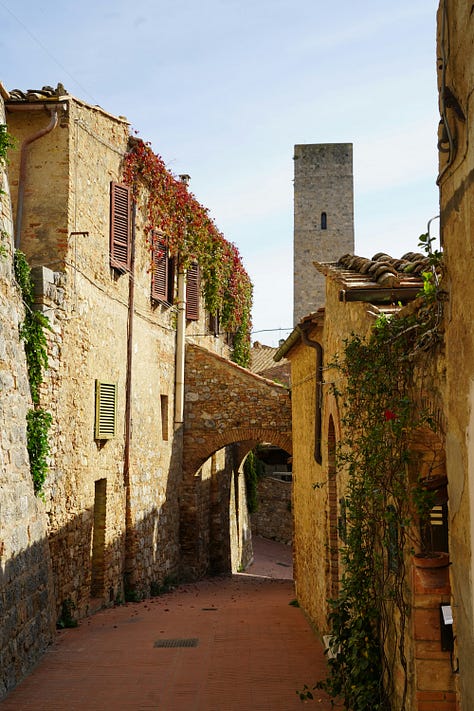
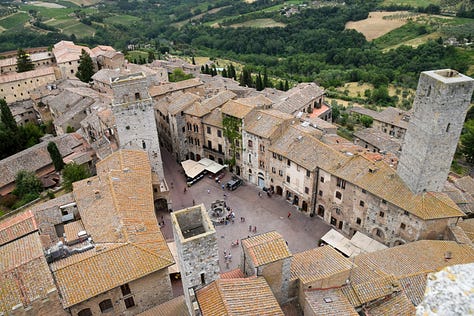
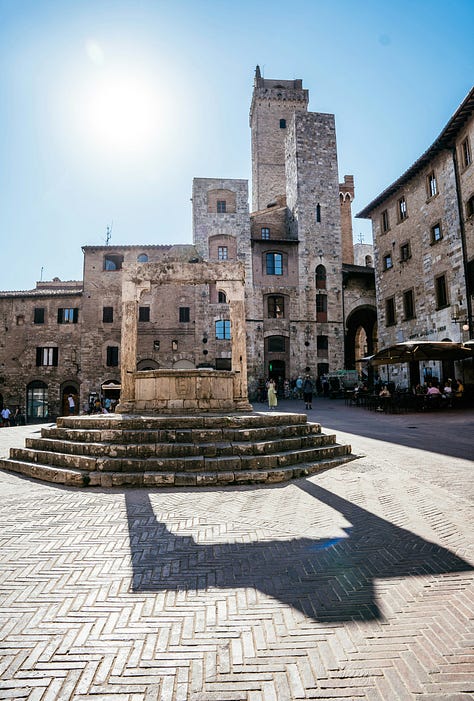
A Journey Through Time: The History of San Gimignano
The origins of San Gimignano blend legend and history. According to tradition, it was founded in 63 BC by two Roman patricians, Muzio and Silvio, fleeing Rome after being implicated in Catiline’s conspiracy. They are said to have built two castles, one of which evolved into the future San Gimignano.
The first official mention of the town appears in a document from August 30, 929 AD, when Ugo of Provence granted land "near Saint Geminianus." The name likely comes from Saint Geminianus, the Bishop of Modena, who according to legend miraculously saved the town from barbarian invasions by appearing on its walls.
In the 10th century, San Gimignano was a feudal possession of the Bishop of Volterra and a strategic stop along the Via Francigena, the famous pilgrimage route to Rome. This location brought not only travelers but prosperity. By 1199, the town declared itself a free commune, flourishing through agriculture (notably saffron), trade, and banking.
Its golden era lasted until the mid-14th century, when the Black Plague of 1348 devastated two-thirds of the population. In the aftermath, the town fell under Florentine control, entering a long period of decline that ironically helped preserve its medieval charm. By avoiding large-scale "modernizations," San Gimignano reached the 19th and 20th centuries with its historical character mostly intact.
Today, with around 8,000 residents, San Gimignano thrives again thanks to wine production, agritourism, and the growing appeal of cultural travel.
Flavors of the Land: Wine, Food, and More
San Gimignano is more than just towers and frescoes, it’s also a land of intense flavors, deeply rooted in centuries-old traditions. The town is especially renowned for its production of Vernaccia di San Gimignano, one of the most iconic white wines in Italy.
Cultivated exclusively in this area since at least the 13th century, Vernaccia was praised by none other than Dante Alighieri in his Divine Comedy, and later by popes and Renaissance poets. It’s a wine with character, dry, mineral, with a slightly bitter almond finish, and it reflects the sandy, ancient soils of this hilltop land.
In 1966, Vernaccia became the first Italian wine to be granted DOC status, and in 1993, it was elevated to the prestigious DOCG (Denominazione di Origine Controllata e Garantita). This recognition isn’t just bureaucratic: it speaks to a legacy of careful winemaking and the deep bond between grape and territory.
Visiting one of the local wineries, you can experience this firsthand. Many are still family-run, and offer guided tastings that include not only the wine itself but also insights into the land, the history, and the passion behind each bottle. Pair it with local pecorino, Tuscan salumi, or a light saffron risotto for an unforgettable moment.
And speaking of saffron, San Gimignano’s “oro rosso” (red gold), don’t miss trying dishes that include this precious spice. It has been grown here since the Middle Ages, originally used not just for food, but also as a dye and even currency. Today, it’s protected by a D.O.P. (Protected Designation of Origin) and plays a key role in the local culinary identity.
Medieval Heart, Contemporary Soul
Though San Gimignano is often described as a “frozen-in-time” medieval town, a closer look reveals a vibrant dialogue between past and present, especially when it comes to art. Since the early 1990s, the town has been actively engaging with contemporary artistic languages, not by building new galleries, but by integrating art into its historical fabric.
The project Arte all’Arte, curated by the Associazione Continua, has brought some of the most influential contemporary artists to work in situ, creating works that subtly interact with the ancient walls, streets, and towers of San Gimignano.
For example, Jannis Kounellis, a pioneer of Arte Povera, installed a site-specific work that contrasts modern industrial materials with the textures of the past. Nearby, the minimal interventions of Giulio Paolini and Giovanni Anselmo create poetic tensions between history and abstraction, silence and meaning.
Even walking through the Rocca di Montestaffoli, you might stumble upon the sculptural installation Acqua e Sole, a meditative piece that adds a sensory, contemporary layer to the panoramic ruins of the old fortress.
The town is also home to the internationally acclaimed Galleria Continua, located in a former cinema. It’s one of the most important contemporary art spaces in Italy, and its presence here, in a small hilltown rather than a major city, reflects a broader vision: art belongs everywhere, not just in capital cities or white cubes.
In this way, San Gimignano isn’t just preserving history, it’s living it forward, embracing beauty in all its forms: medieval, modern, and everything in between.
Traditional Dining Gems in San Gimignano
For those seeking authentic Tuscan flavors in a genuine setting, Da Pode and Le Vecchie Mura stand out as must-visit culinary spots:
📍 Ristorante Da Pode – Just outside San Gimignano, in a converted farmhouse surrounded by vineyards and olive groves, Da Pode offers hearty Tuscan cuisine rooted in family tradition. Dishes like ribollita, handmade pici, and Chianina steak are served with estate-produced wine and olive oil. Warm, rustic hospitality completes the experience.
📞 +39 0577 943118
📧 info@hotelsovestro.com
📍 Località Sovestro, San Gimignano
📍 Le Vecchie Mura – Tucked within the medieval walls, this restaurant boasts a terrace with panoramic views of the Val d’Elsa. Traditional recipes, such as wild boar with Vernaccia, Fiorentina steak, and Tuscan bean stews, are served in an elegant yet homey setting, perfect for sunset dinners or quiet lunches.
📞 +39 0577 940270
📧 info@vecchiemura.it
📍 Via Piandornella 15, San Gimignano
coff.ee/christinemytuscanyroots
Thank you so much for reading this post! I can't wait to continue my journey and explore new places with you, always carrying a piece of Tuscany with me and with you.


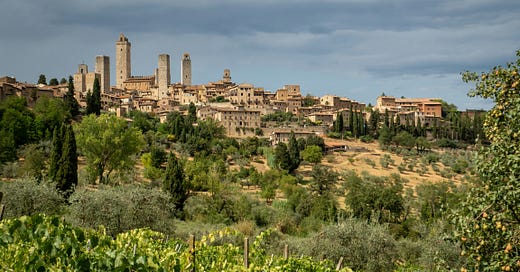



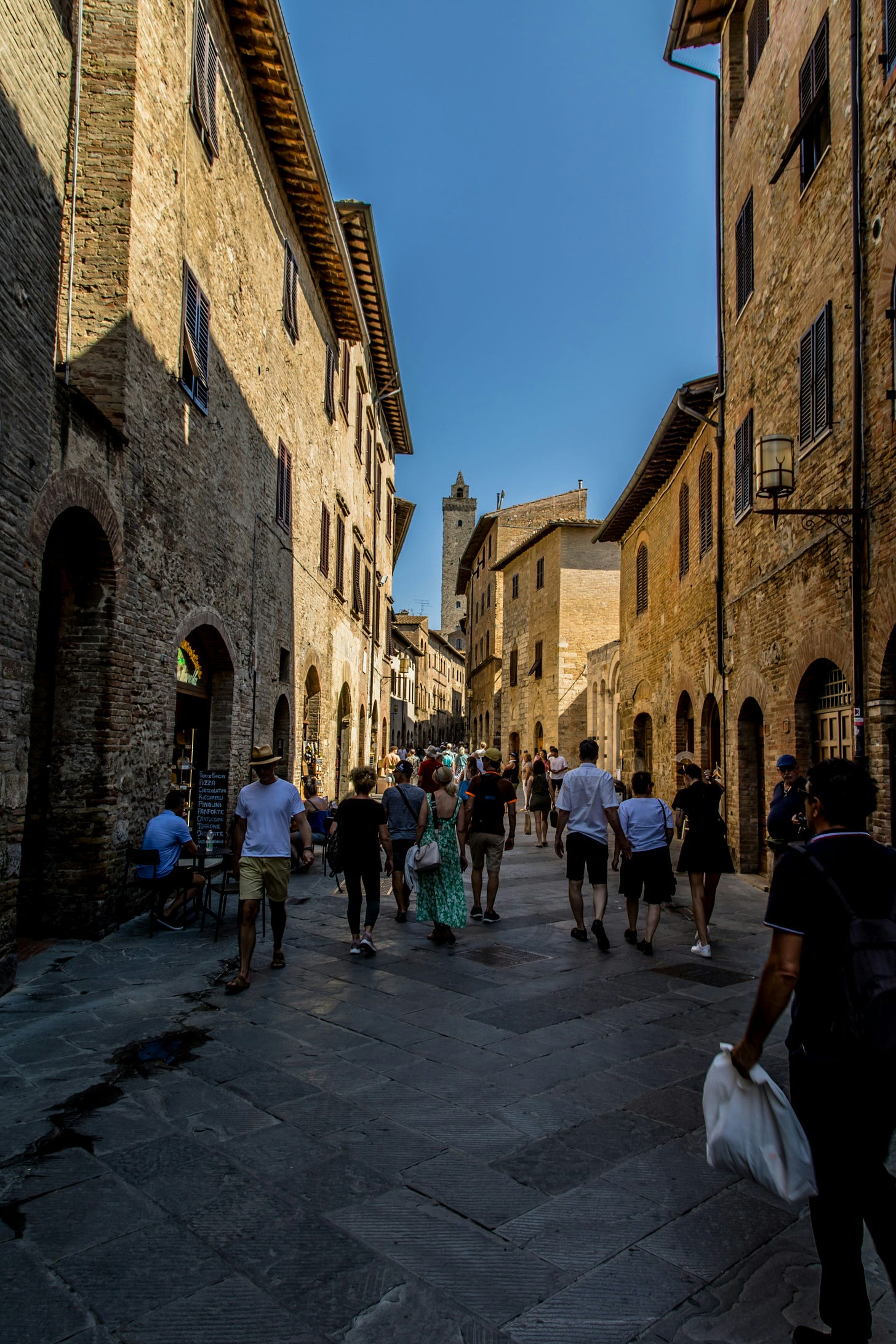
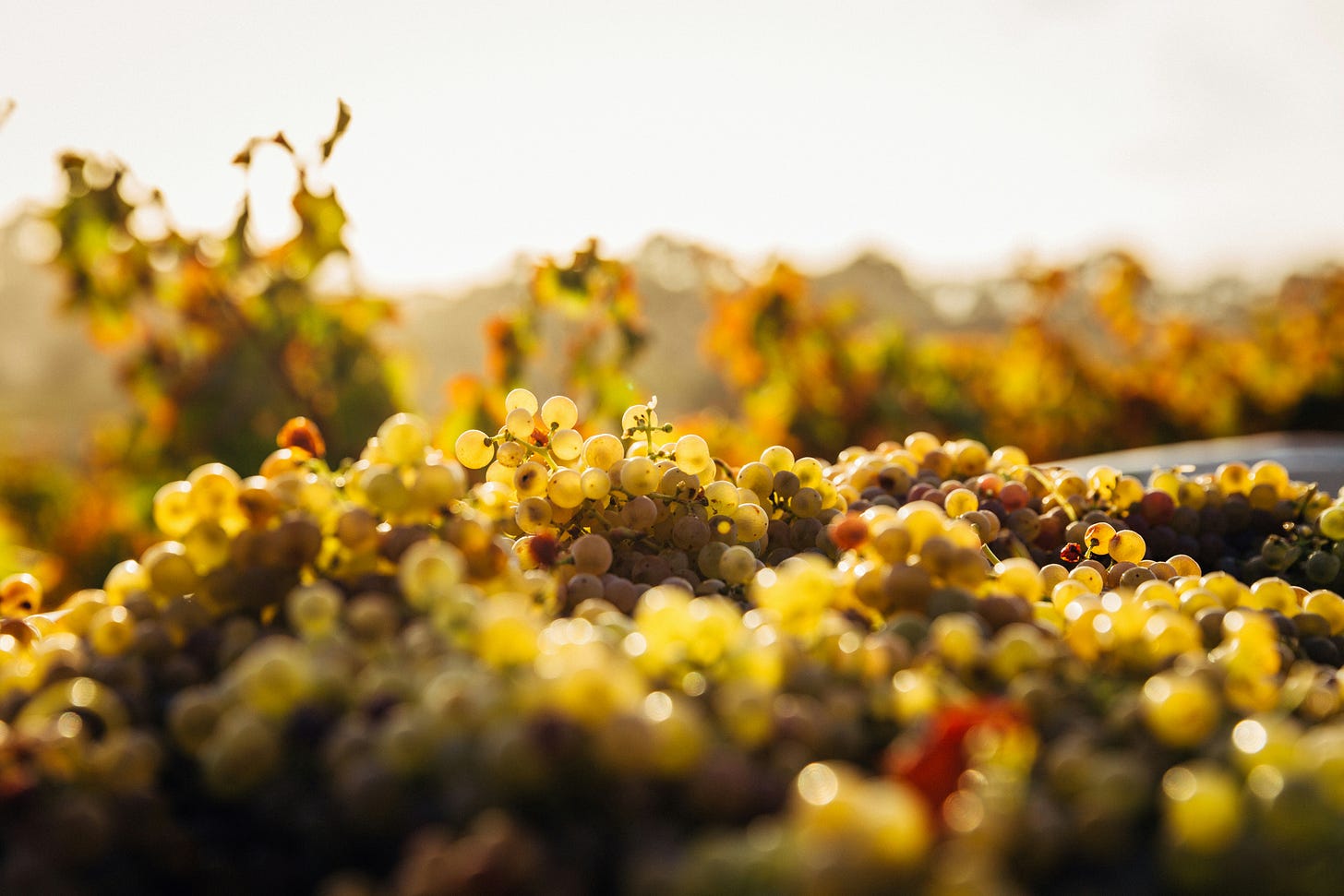

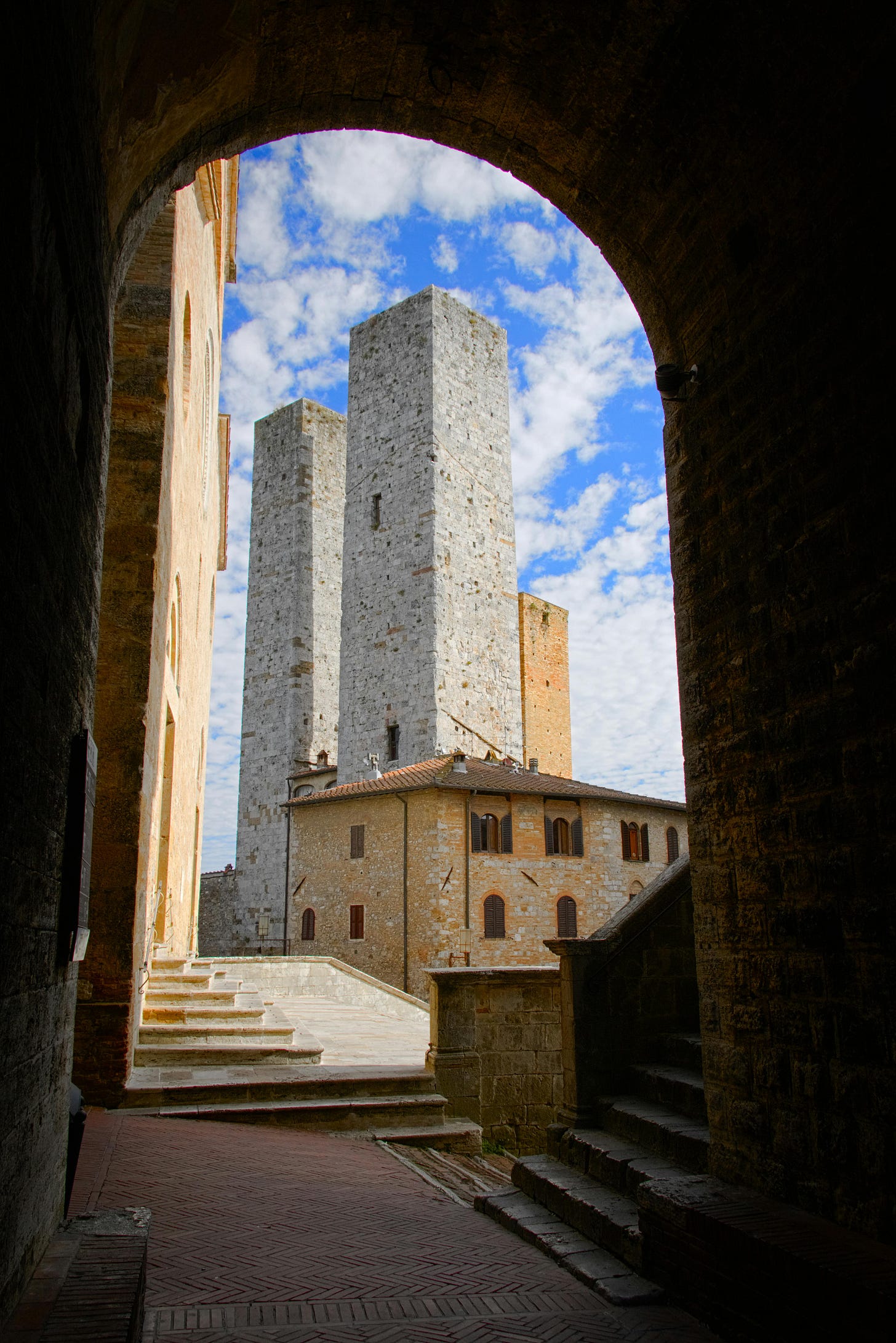
San Gimignano really is such a little gem ❤️
I love that you posted this. I am currently working on a post about my visit to San Gimignano! What a magical place. xoxoxo ~ bek